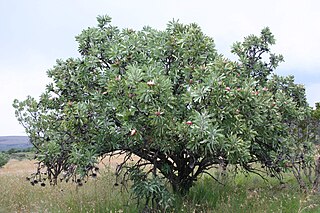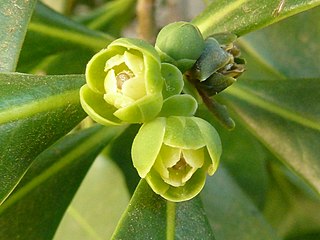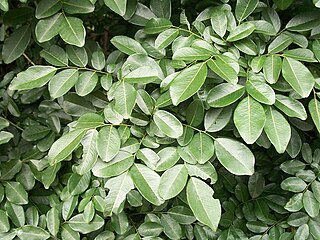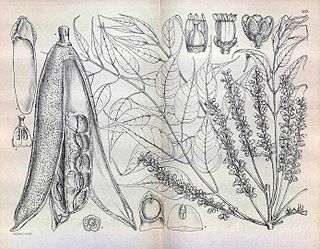
Brachystegia boehmii, named after the 19th-century German naturalist and collector Richard Böhm, is a flat-topped tree with spreading crown, native to eastern and southern Africa. It forms an important component of miombo woodland, and occurs in Angola, Botswana, Democratic Republic of the Congo, Malawi, Mozambique, Zimbabwe, and Zambia. Common names are machabel (Mashonaland), mufuti (Zimbabwe) and Prince of Wales feathers.

Combretum imberbe is a characteristic and often impressive bushwillow species of the southern Afrotropics. The medium to large tree has a sparse, semi-deciduous canopy of grey-green leaves. The twigs and leaves are hairless as the name imberbe suggests. Its heartwood is dark brown, close-grained, and very hard and heavy, as suggested by its vernacular name. The durable heartwood is much sought after in the woodcarving industry. The Hereros and Ovambos of Namibia attach special cultural and religious significance to the tree, as to them it is the great ancestor of all animals and people, which must be passed with respect.
Androstachys johnsonii, the Lebombo ironwood, is a medium-sized Afrotropical tree species, and the sole member of the genus Androstachys in the Picrodendraceae. It is slow-growing, evergreen to deciduous, and dioecious, with flowers that are wind-pollinated. It is native to southeastern Africa and Madagascar, where it generally occurs gregariously on rocky hillsides, particularly in hot and dry situations. It produces a hard, durable wood which is of economic interest. Its specific name commemorates W. H. Johnson, a 19th-century Director of Agriculture in Mozambique. Four related species which are native to Madagascar, are usually placed in genus Stachyandra.

Pterocarpus angolensis is a species of Pterocarpus native to southern Africa, in Angola, Mozambique, Namibia, South Africa, Eswatini, Tanzania, Democratic Republic of the Congo, Zimbabwe, and Zambia. It is a protected tree in South Africa. The name Kiaat, although Afrikaans, is sometimes used outside South Africa as well. In Zimbabwe, depending on what region you are in, it is known as Mukwa or Mubvamaropa.

Toona ciliata is a forest tree in the mahogany family which grows throughout southern Asia from Afghanistan to Papua New Guinea and Australia.

Leucosidea sericea, commonly known as oldwood, is an evergreen tree or large shrub that grows in the highland regions of southern Africa. It is the sole species in the monotypic genus Leucosidea. The name oldwood may reflect the fact that the wood burns slowly, as if old and rotting; the gnarled, twisted trunks reinforce this impression.

Protea caffra, native to South Africa, is a small tree or shrub which occurs in open or wooded grassland, usually on rocky ridges. Its leaves are leathery and hairless. The flower head is solitary or in clusters of 3 or 4 with the involucral bracts a pale red, pink or cream colour. The fruit is a densely hairy nut. The species is highly variable and has several subspecies.

Warburgia salutaris is a species of tree in the family Canellaceae. It is found in eastern and southern African locations e.g. Botswana, Namibia, Kenya, Tanzania, Zambia, Mozambique, South Africa, Eswatini, Malawi and Zimbabwe. It is threatened by habitat loss. It is a popular medicinal plant and is overharvested in the wild, another reason for its endangerment. The Pepper-bark tree is a protected tree in South Africa. Various projects are investigating methods of propagation under controlled conditions with subsequent planting in the wild.

Southern African Sand Forest is a sand forest, or a subtropical forest plant community of the tropical and subtropical dry broadleaf forests biome. It grows on ancient sand dunes in northern KwaZulu-Natal and southern Mozambique. In South Africa these forests are known simply as Sand Forest, while in Mozambique they are known as Licuati Forest. The Southern African sand forest is part of the Maputaland coastal forest mosaic ecoregion.

Dalbergia obovata is a robust shrub or climber in the family Fabaceae, and is native to Southern Africa.

Erythrophleum suaveolens, also known as the ordeal tree, is a species of flowering plant that can be found across most of tropical Africa. The species are 20 metres (66 ft) in height, and have a rough and blackish bark. The plants leaves have 2–3 pairs of pinnae, which carry 7–13 leaflets. The leaflets are 5 by 2.5 centimetres, are green coloured and ovate. The flowers have fluffy spikes, and are creamy-yellow coloured. Fruits are hard, the pod of which is flat.
Commiphora africana, commonly called African myrrh, is a small deciduous tree belonging to the Burseraceae, a family akin to the Anacardiaceae, occurring widely over sub-Saharan Africa in Angola, Botswana, Burkina Faso, Chad, Eswatini, Eritrea, Ethiopia, Kenya, Mali, Mauritania, Mozambique, Namibia, Niger, Senegal, Somalia, South Africa, Sudan, Tanzania, Uganda, Zambia and Zimbabwe. On sandy soils this species sometimes forms pure stands, deserving consideration as a plant community or association.

Newtonia hildebrandtii, the Lebombo wattle, is a medium-sized tree native to eastern Africa. It is a protected tree in South Africa.

Maerua cafra (DC.) Pax is a small Southern African tree belonging to Capparaceae, the caper family, occurring eastwards along the coast from Knysna, then further inland and northwards through KwaZulu-Natal and Eswatini to the Transvaal, southern Mozambique and southern Zimbabwe. The genus Maerua comprises about 60 species found in Africa and Asia.

Entandrophragma caudatum, or mountain mahogany, is a large Southern African tree belonging to the mahogany family and found in eastern and north eastern South Africa, Eswatini, Botswana, Angola, the Caprivi Strip region of Namibia, Zimbabwe, Zambia and Malawi. Kew currently recognises 12 other species of Entandrophragma, all with a tropical and sub-tropical African distribution.

Dalbergia armata is a scrambling, deciduous species of legume that is native to subtropical to temperate regions of southeastern Africa. The robust, woody liana or small tree is armed with strong spines on the main stem and branches. It occurs sparsely or commonly in forest, bush, riparian fringes and in wooded ravines. It is sometimes employed as a bonsai subject, and it can be propagated from either seed or cuttings.

Schefflera umbellifera is an evergreen to semi-deciduous Southern African tree of 15-20m growing in escarpment and coastal forest in Malawi, through eastern Zimbabwe and Mozambique along the east coast to South Africa, as far south as the Garden Route. It belongs to the Araliaceae or Cabbage Tree family and is one of some 600 species in the genus Schefflera, created by J.R.Forst. & G.Forst. in 1776 to honour the 18th century German physician and botanist Johann Peter Ernst von Scheffler of Danzig, and not to be confused with writer and physician Jacob Christoph Scheffler (1698-1745) of Altdorf bei Nürnberg.

Pterocelastrus echinatus is a small Southern African tree occurring in South Africa, Mozambique, Zimbabwe, Eswatini, and Malawi. This species is found in montane and submontane evergreen forests, forest margins, rocky hillsides, and kloofs, growing between 600 and 2400 m above sea level.

Drypetes arguta, commonly known as the water ironplum, is a species of small tree or large bush in the family Putranjivaceae. It is native to tropical East Africa. It was first described in 1920 by the English botanist John Hutchinson, who named it Cyclostemon argutus. It was later transferred to the genus Drypetes.

Gardenia volkensii, commonly known as bushveldt gardenia or Transvaal gardenia, is a species of plant in the family Rubiaceae native to southern Africa.




















